The state-of-the-art of atmospheric pressure plasma for transdermal drug delivery
Lanlan NIE (聶蘭蘭),Dawei LIU (劉大偉),He CHENG (程鶴),Feng ZHAO (趙峰) and Xinpei LU (盧新培),*
1 State key laboratory of advanced electromagnetic engineering and technology,School of Electrical and Electronic Engineering,Huazhong University of Science and Technology,Wuhan 430074,People’s Republic of China
2 School of Chemistry and Chemical Engineering,Nanjing University of Science and Technology,Nanjing 210094,People’s Republic of China
3 Department of Thoracic Surgery,Union Hospital,Tongji Medical College,Huazhong University of Science and Technology,Wuhan 430022,People’s Republic of China
Abstract Plasma-enhanced transdermal drug delivery (TDD) presents advantages over traditional methods,including painless application,minimal skin damage,and rapid recovery of permeability.To harness its clinical potential,factors related to plasma’s unique properties,such as reactive species and electric fields,must be carefully considered.This review provides a concise summary of conventional TDD methods and subsequently offers a comprehensive examination of the current state-of-the-art in plasma-enhanced TDD.This includes an analysis of the impact of plasma on HaCaT human keratinocyte cells,ex vivo/in vivo studies,and clinical research on plasma-assisted TDD.Moreover,the review explores the effects of plasma on skin physical characteristics such as microhole formation,transepidermal water loss (TEWL),molecular structure of the stratum corneum (SC),and skin resistance.Additionally,it discusses the involvement of various reactive agents in plasma-enhanced TDD,encompassing electric fields,charged particles,UV/VUV radiation,heat,and reactive species.Lastly,the review briefly addresses the temporal behavior of the skin after plasma treatment,safety considerations,and potential risks associated with plasma-enhanced TDD.
Keywords: plasma,transdermal drug delivery,skin physical characteristics,reactive agents
1.Introduction
The skin,which is the largest organ in the human body,is comprised of multiple layers of ectodermal tissue that serve to protect the underlying muscles,bones,ligaments,and internal organs [1,2].Not only does it function as a barrier against microorganisms,toxins,and ultraviolet radiation,but it is also an active organ involved in various physiological processes including metabolism,sensation,temperature regulation,and immunology.Additionally,it plays a crucial role in preventing water and electrolyte loss in human beings.
Furthermore,the skin serves as an interface for both topical and systemic drug administration [3,4].Transdermal drug delivery (TDD) is an innovative alternative to oral administration or injections,offering numerous advantages such as bypassing the gastrointestinal tract to avoid first-pass side effects associated with oral applications.Moreover,TDD has the potential to be a painless and self-administered method,unlike injections.
The outermost layer of the skin,known as the stratum corneum (SC),consists of dead cells called corneocytes,and it presents a barrier to dermal and transdermal drug delivery due to its poor permeability.Currently,only a limited range of drugs with molecular masses up to a few hundred Daltons(Da) can be effectively delivered through the skin using existing methods.The delivery of peptides and macromolecules,including genetic treatments like DNA,RNA,or vaccines,has been particularly difficult to achieve through the skin.
Recent research has demonstrated that plasma,a state of matter comprising charged particles,holds potential for enhancing TDD.It has been discovered that plasma can improve the delivery of not only small molecules but also larger proteins,including those with a molecular weight of 8.6 kDa,such as His-tagged EGF.In this paper,we will begin with a brief overview of traditional transdermal drug delivery methods,followed by a comprehensive review of the current state-of-the-art plasma-enhanced TDD.Finally,we will present a concise conclusion.
2.Brief review of traditional TDD
Extensive research has been dedicated to overcoming the obstacles of delivering drugs through the skin over the past few decades.However,the progress in developing TDD has been relatively slow.The techniques that have emerged can be broadly classified into two categories: passive and active methods.
Passive methods mainly involve the use of chemical enhancers to facilitate drug penetration.These enhancers can modify the properties of the stratum corneum (SC) and improve drug permeation.Various types of chemical enhancers have been investigated and employed in transdermal drug delivery.
On the other hand,active methods encompass a diverse range of approaches that have been extensively studied and some have even been applied in clinical practice.These methods involve mechanisms such as iontophoresis,which uses an electric current to drive drug molecules into the skin,and sonophoresis,which employs ultrasound waves to enhance drug penetration.Other active methods include microneedles,which create tiny channels in the skin for drug delivery,and electroporation,which uses short electrical pulses to increase skin permeability.
In the following part of this section,a concise overview some of these methods will be provided,highlighting their principles and potential applications.
2.1.Chemical enhancer
Chemical enhancers function by increasing the permeability of the skin through various mechanisms.These include enhancing solubility,increasing partitioning into the SC,fluidizing the crystalline structure of the SC,and causing dissolution of SC lipids [5,6].However,only a small number of chemical enhancers have been proven to significantly enhance drug transport in a therapeutic manner.Currently,the smallest drug formulated in a patch is nicotine (162 Da),while the largest is oxybutynin (359 Da).Both of the drugs have been effectively utilized in clinical settings[7].Nevertheless,the enhanced delivery of high-molecularmass drugs remains limited.
2.2.Temperature (“Thermophoresis”)
The usual surface temperature of the skin is maintained at 32 °C.Studies conducted in a laboratory setting [8–10] have shown that for every 7 °C–8 °C rise in the skin’s surface temperature,there is a 2–3-fold increase in the rate at which drugs pass through.This temperature-related effect is believed to result from enhanced drug diffusion in the vehicle (i.e.,the dosage form) and increased fluidity of the skin’s lipid layer [11].Additionally,in vivo studies have indicated that the increased blood flow to the skin surface caused by higher temperatures also plays a vital role in enhancing the delivery of drugs through the skin [12].
2.3.Sonophoresis
Sonophoresis is a technique that utilizes ultrasound at various frequencies,ranging from 20 kHz to 16 MHz,to enhance the permeability of the skin.This method has proven effective in enhancing the transdermal transport of high-molecular weight drugs such as insulin,erythropoietin,interferon,and low-molecular weight heparin,both in vitro and in vivo [13–15].Ultrasound has the capability to rapidly increase the permeability of human skin and maintain it in a highly permeable state for several hours [16].
However,the exact mechanism behind sonophoresis is not yet fully understood,although several proposed mechanisms have been suggested.One proposed mechanism is the thermal effects caused by the absorption of ultrasound energy.Another proposed mechanism is cavitation,which refers to the formation of small gaseous cavities during the pressure cycles of ultrasound waves [17–21].The occurrence of cavitation depends on various factors,including the ultrasound frequency and the characteristics of the gas bubbles,such as their size and shape.Cavitation can be categorized into two types: stable cavitation and inertial cavitation,based on the behavior of the gaseous bubbles in relation to the acoustic field [22–27].
2.4.Laser
Laser technology can also be used for the delivery of macromolecules and nanoparticles into the skin by ablating the SC.Two commonly studied types of lasers for laser-assisted drug delivery are erbium:yttrium-aluminum-garnet (Er:YAG) laser with a wavelength of 2940 nm and CO2laser with a wavelength of 10,600 nm.
The Er:YAG laser causes minimal heat generation and minimal thermal damage,as it primarily focuses on ablating the SC with minimal penetration depth [28–30].On the other hand,the CO2laser has a greater thermal effect,which may result in increased skin permeability [31].
Fractional lasers divide the laser beam into microbeams,creating microscopic vertical channels of ablation in the skin known as microthermal zones.These microchannels serve as pathways for macromolecules to enter the skin while minimizing the required healing time after continuous laser ablation.By creating these microthermal zones,fractional lasers offer a controlled and precise method for drug delivery [32].
The total energy of the laser used for TDD typically ranges from several hundred mJ/cm2to several J/cm2,with ablation depths ranging from tens to hundreds of micrometers [33].This allows for customization and optimization of laser parameters depending on the specific drug and skin conditions.
2.5.Microjets
Microjet delivery is another technique for delivering macromolecules across the skin using pulsed microjets.In this method,a high-velocity microjet with a speed of over 100 m/s is used to propel the drug into the skin.The volume of the model drug is typically in the nanolitre range.
The high velocity of the microjet enables it to penetrate the skin,while the small jet diameters (50–100μm) and volumes of 2–15 nL limit the depth of penetration to around 200μm.This controlled penetration depth ensures localized and targeted drug delivery.
Microjet delivery has been tested with insulin as a model drug and has shown promising results.Compared to other TDD techniques,microjet delivery allows for more precise dosing of insulin,which is crucial for managing blood sugar levels accurately [34,35].
2.6.Iontophoresis
Iontophoresis involves the use of a mild electrical current to deliver medication or other therapeutic agents through the skin and into the underlying tissues.It is commonly used in various medical fields,including dermatology and physical therapy.Iontophoresis works based on the principles of electromigration and electrorepulsion.When an electric current is applied to the skin,it creates an electric field.This field causes charged particles (ions) to move towards the oppositely charged electrode.For example,if a positively charged medication (cation) is placed on the anode (positive electrode),the electric field will drive the medication ions into the skin.Details about iontophoresis can be found in the recent review papers such as references [36–38].
2.7.Microneedle
Microneedles are tiny,minimally invasive devices that are used for drug delivery through the skin.They work on the principle of creating micro-sized channels or pores in the stratum corneum to enhance the delivery of drugs or other therapeutic agents.There are several mechanisms involved in how microneedles facilitate drug delivery as follows:
By bypassing the stratum corneum,microneedles enable drugs to reach deeper layers of the skin,where they can be absorbed more efficiently into the bloodstream.This can improve drug bioavailability and reduce the need for high drug doses.
Microneedles are designed to be very small and fine,often causing minimal pain or discomfort compared to traditional hypodermic needles.This makes them a more patientfriendly option for drug delivery.
Some microneedle systems are designed with drugloaded patches or reservoirs that release drugs slowly and consistently into the skin.This controlled release mechanism can enhance drug delivery precision and reduce the risk of overdose.
Microneedles can be designed to target specific regions of the skin or underlying tissues,allowing for localized drug delivery.This is particularly useful for conditions that require targeted therapy,such as skin diseases or localized pain management.
Overall,microneedles offer a promising approach for drug delivery,especially for drugs that are poorly absorbed through the skin or when a less invasive and more patientfriendly method is desired.Researchers continue to explore and develop various types of microneedle technologies to optimize drug delivery for a wide range of medical applications.Details about microneedles research can be found in the recent review papers [39–42].
2.8.Electroporation
2.8.1.Traditional electroporationTraditional electroporation,first reported in 1982,involves the use of pulsed electric fields to temporarily permeabilize cell membranes for delivering foreign DNA into cells [43].This technique has been widely used for in vitro transfection of animal and plant cells [44–48].
To achieve electroporation,a transmembrane voltage of at least 0.2 V is required,typically ranging from 0.5 to 1 V[49].The effectiveness of electroporation is highly influenced by various operational parameters such as pulse duration,number of pulses,and magnitude of the voltage [50,51].
In one study,it was shown that an electric field of 100 V/cm for 100μs achieved the same electroporation effect as that of 25 V/cm for 160 ms [52].This suggests that the duration and magnitude of the electric field can be adjusted to achieve the desired effect in electroporation.
Traditional electroporation methods commonly utilize pulses with durations ranging from tens of milliseconds to a few microseconds.The electric field amplitudes used in these methods can range from several tens of kilovolts per meter (kV/m) to several hundred kV/m [53].
Figure 1 illustrates the effects on the cell membrane,including poration and thermal effects,when cells are exposed to an electric field for varying durations.The figure provides a visual representation of how different electric field strength and exposure durations can impact the cells during electroporation.
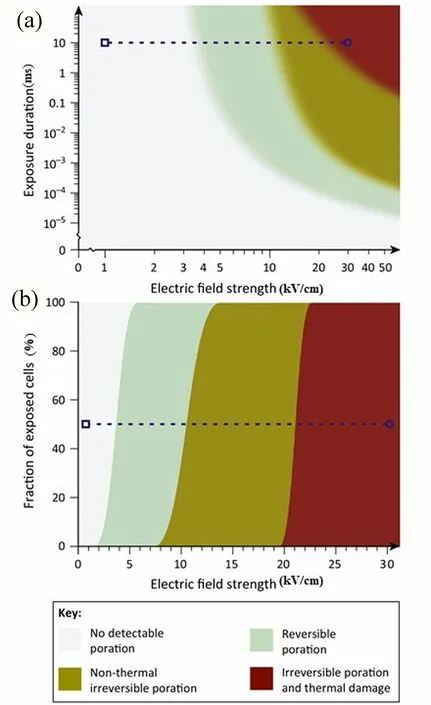
Figure 1.Membrane poration and thermal effects during exposure of cells to an electric field.The values are for typical bacteria in 0.25 M sucrose.(a) Ranges of no detectable poration,reversible poration,irreversible poration,and thermal damage as functions of field strength and duration.(b) Fractions of non-porated,reversibly porated,irreversibly porated,and thermally damaged cells as functions of field strength,for a 10 ms exposure time [i.e.,the plot in panel (b) traces these fractions along the dashed line segment in panel (a)].Note that the axes are logarithmic in (a) and linear in(b).Reprinted from [54],Copyright (2015),with permission from Elsevier.
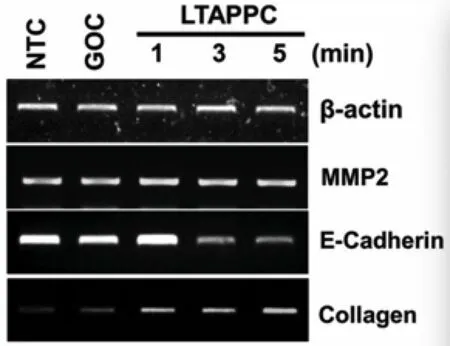
Figure 2.The expression pattern of the genes related to the skin barrier function after treatment.NTC: Non Treatment Cells;GOC:5 min Gas Only treatment Cells;LTAPPC: Low Temperature Atmosspheric Pressure Plasma treatment Cells for different times.[101] (2014) (?Springer-Verlag Berlin Heidelberg 2014).With permission of Springer.
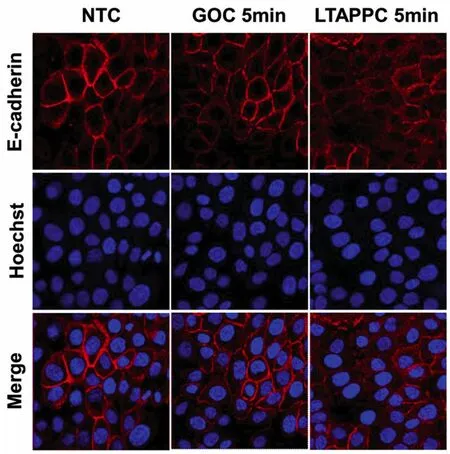
Figure 3.The effect of plasma treatment on cellular E-cadherin localization.NTC: Non Treatment Cells;GOC: 5 min Gas Only treatment Cells;LTAPPC: Low Temperature Atmosspheric Pressure Plasma treatment Cells for 5 min.[101] (2014) (?Springer-Verlag Berlin Heidelberg 2014).With permission of Springer.
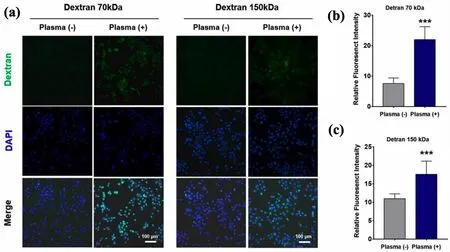
Figure 4.Cellular permeability of 70 kDa and 150 kDa dextran by argon plasma irradiation in keratinocytes.(a) Fluorescence images,HaCaT cells were treated with argon plasma for 30 s and then subjected to fluorescein-dextran 70 or 150 kDa.(b) and (c) Statistical results of relative fluorescence in the cells treated with 70 kDa (b) and 150 kDa (c) dextran in the presence and absence of argon plasma irradiation.Scale bar indicates 100 μm.The fluorescent intensity was averaged from 40 cells.Data are presented as means ± S.D.*** p < 0.001 compared to the nontreated control (unpaired two-tailed t-test) [103].
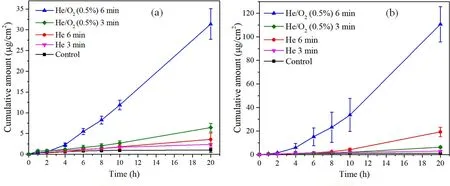
Figure 5.Patent blue V permeation cumulative amount through skin sample (a) under 7 kV and 7 kHz plasma jet treatment,(b) under 9 kV and 9 kHz plasma jet treatment.The error bars indicate standard errors (n ≥ 3).[110] John Wiley &Sons.[?2020 Wiley-VCH GmbH]
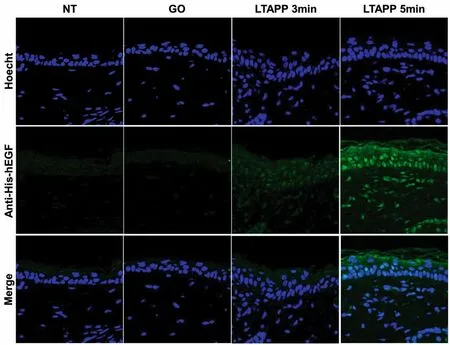
Figure 6.Plasma treatment increases the transdermal delivery of hEGF through the in vivo skin absorption assay using a His-tag hEGF patch.[101] (2014) (?Springer-Verlag Berlin Heidelberg 2014).With permission of Springer.
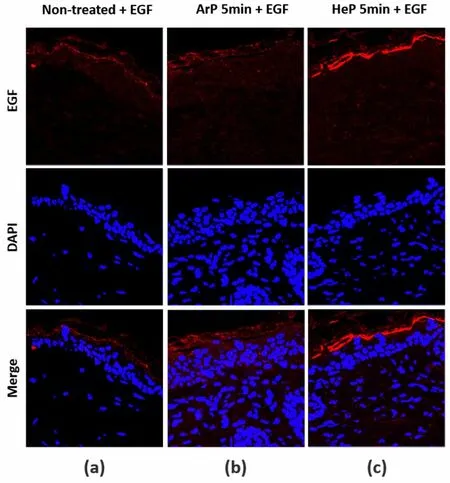
Figure 7.EGF absorption efficacy of (a) non-treated,(b) argon plasma (ArP) treated,and (c) helium plasma (HeP) treated skin.Reproduced from [102].?IOP Publishing Ltd.All rights reserved.
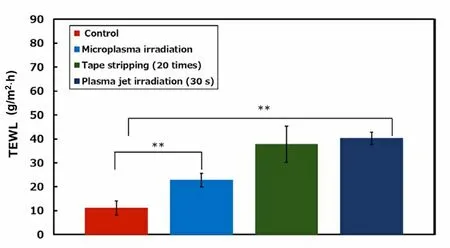
Figure 8.TEWL measurements of a control sample of the pig skin,after 5 min of surface DBD,20 cycles of the tape stripping test,and 30 s of plasma jet treatment.Reproduced from [106].?IOP Publishing Ltd.All rights reserved.
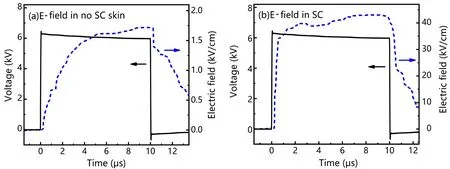
Figure 9.Applied voltage waveform and the electric fields in (a) the viable epidermis and dermis layer EnSC and (b) in the SC ESC.Reprinted from [116],Copyright (2021),with permission from Elsevier.

Figure 10.Simulated 2D potential profiles (a) without mesh: plasma is in direct contact with skin,(b) with a dielectric mesh: the mesh is placed between the plasma jet and skin,and (c) with a grounded metal mesh: a grounded metal mesh is placed between the plasma and skin.Reproduced from [102].?IOP Publishing Ltd.All rights reserved.
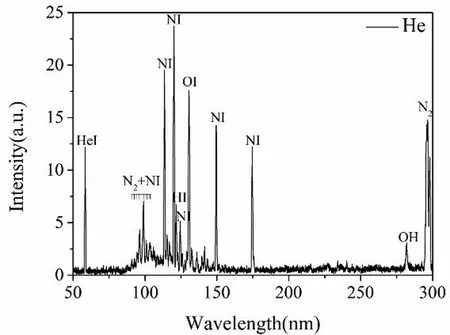
Figure 11.Emission spectra range from 50 nm to 300 nm of a helium plasma jet in surrounding air.Reproduced from [86].? IOP Publishing Ltd.All rights reserved.
In cases where electroporation is not detectable,it suggests that the pores created in the cell membrane are either too small or short-lived to allow for measurable molecular transport.These small or short-lived pores do not facilitate sufficient transport of molecules across the membrane.
Reversible electroporation,on the other hand,involves the creation of temporary pores that allow for molecular transport.These pores reseal gradually after the electric pulse,preventing further transport.However,most cells remain viable after the reversible electroporation process.
In nonthermal irreversible electroporation,the pores either do not reseal or reseal too slowly to maintain cell viability.As a result,irreversible changes occur in the cell membrane,leading to loss of cell viability.
Irreversible electroporation with thermal damage occurs when the electric current generates enough heat to cause thermal damage to the cells.The high temperatures can lead to irreversible damage to cellular components,compromising cell viability.
One promising application of irreversible electroporation (IRE) is in the ablation of solid tumors [55,56].In this treatment approach,two needle electrodes are used to deliver a series of pulses with specific parameters.Typically,the treatment protocol involves delivering 80–120 pulses with a duration of 50–100μs and an electric field strength greater than 1000 V/cm [57].This targeted application of irreversible electroporation can effectively destroy tumor cells while preserving the surrounding healthy tissue.
The pores formed in the bilayer typically have radii that are several nanometers at most,which makes them too small to be observed using optical microscopy.Additionally,the sample preparation required for electron microscopy of soft matter,such as vacuumization,fixation,and/or metallic coating,can be too harsh and may not reliably preserve the semistable structures in the bilayer.This makes it difficult to clearly distinguish natural pores from artifacts.However,there is compelling evidence that supports the theory of pore formation through molecular dynamics simulations.These simulations not only confirm the hypothesized sequence of molecular-scale events,but also demonstrate a clear increase in the rate of pore formation when higher electric fields are applied to the membrane.This increase is initially caused by the direct action of the external field and is further augmented by the induction of transmembrane voltage resulting from polarization [56].
Efforts have been extensively made to minimize the unpleasant pain sensations experienced by patients as a side effect of electroporation.Studies have revealed that the size of the electrode-skin contact area and the distance between electrodes play significant roles in influencing pain sensation.By reducing both dimensions to approximately 0.5 mm,pain levels become imperceptible even at the threshold of transdermal electroporation [58].Moreover,employing voltage pulse frequencies around one hundred Hz has been found to decrease the occurrence of individual muscle contractions to a single contraction,presenting potential advantages for clinical applications of high-frequency pulses in electrochemotherapy [59].Nevertheless,it is important to note that high pulse frequencies can lead to notable tissue heating.Simulations have demonstrated that traditional electroporation electrode designs can induce muscle contractions in unexpectedly large volumes of non-target tissue surrounding the treated area.Alternatively,utilizing an electrode design known as the “Current Cage” can significantly minimize the volume of non-target tissue exposed to these fields [60].Furthermore,experiments conducted with rabbit liver tissues have demonstrated that the use of insulated needle electrodes,wherein an insulating coating is applied to the outer surface of the needle electrode tip,mitigates the extent of muscle contractions during high frequency irreversible electroporation (H-FIRE) and traditional monopolar irreversible electroporation (IRE) [61].
In a study comparing a burst of higher frequency bipolar pulses to a single monopolar pulse,it was discovered that muscle contractions were minimized when using the former,in contrast to the observations with traditional irreversible electroporation (IRE) treatments at the same voltage [62].A recent study conducted by Bhonsleet al[44],applied highfrequency irreversible electroporation (H-FIRE) with an individual pulse width of 2μs on potato tubers,revealing that the lethal electric field threshold of the H-FIRE protocol is 4–5 times higher than that of traditional IRE [44].Another investigation by Sanoet al[45] examined the lethal electric field intensity of H-FIRE in a 3D tissue model.The results showed that for equivalent energy H-FIRE treatments,the lethal electric field intensity increased from 530 V/cm to 2020 V/cm as the pulse width decreased from 50μs to 250 ns [45].However,despite these efforts,it is important to note that muscle contractions cannot be completely avoided during electroporation procedures.
2.8.2.Nanosecond electroporationAs previously mentioned,traditional electroporation typically uses voltage pulses that last for a few microseconds or longer [63].However,Schoenbachet alexpanded the range of pulse durations into the nanosecond range [63].It is widely known that the plasma membrane’s characteristic charging time is approximately 100 ns for many mammalian cells.Therefore,when the pulse width is shorter than this value,the effects of these short pulses can extend into the cell interior [64].This occurs because nanosecond pulses have extremely short rise times,leading to the generation of temporary high electric fields within the cell [65].
The penetration of electric fields into the cell can have significant effects on intracellular organelles.Studies have demonstrated that voltage pulses lasting for hundreds of nanoseconds or less can permeabilize these organelles,creating a new pathway for targeting them.This has various applications,including the activation of platelets and the release of growth factors for accelerated wound healing [67],induction of apoptosis [68,69],and treatment of tumors [70].
Regarding multiple exposures to intense electric field pulses,Schoenbachet alproposed an empirical scaling law relating the intensitySof observable bioelectric effects in a well-defined cell suspension to the number of pulsesN:
whereErepresents the electrical field intensity andτis the pulse duration.The square root ofNdependence can be attributed to the assumption that the position of cells changes randomly with respect to the applied electric field direction between pulses [63].However,it is important to note that this scaling law is based on cells in a suspension medium,where cells have the freedom to move.
When it comes to TDD,where cells are relatively fixed within the skin tissue,a modification of the equation may be necessary to account for the differences in cell behavior.Further research and experimentation are required to develop a more accurate scaling law or model specifically designed for transdermal electroporation.This revised model should consider the unique characteristics and behavior of cells within the skin tissue.
2.8.3.Electroporation for transdermal drug deliveyAs mentioned earlier,electroporation is a technique that enables the formation of pores in the cell membrane,which is primarily composed of a lipid bilayer containing embedded proteins.When the electric field reaches a critical threshold during electroporation,the lipid bilayer undergoes reorganization,resulting in the formation of pores.
Likewise,the primary barrier of the skin is known as the stratum corneum (SC) layer.This layer consists of 15–20 layers of flattened keratinocyte cells lacking nuclei or cell organelles,and it is surrounded by a lipid matrix.When a high voltage is applied to the skin,it has the potential to create channels or pathways for drug delivery,a concept supported by various studies.
Electroporation has undergone extensive research and has emerged as an effective technique for enhancing drug delivery both within and through the skin.This is largely due to the fact that the SC presents a significantly higher electrical resistance compared to the underlying skin layers and tissues.Consequently,when an electric field is applied to the skin,it primarily concentrates within the SC and has a relatively lower impact on the viable tissues,providing protection against potential adverse effects.
Studies on skin electrical impedance have demonstrated that immediately after the application of a pulse voltage,the impedance of the skin decreases significantly within microseconds.However,within milliseconds following the pulse,the impedance increases by at least one order of magnitude.In some cases,the impedance may continue to increase further and eventually return to its original level after seconds,minutes,or even hours [71,72].This indicates that the SC does not sustain long-lasting damage from electroporation.
It is widely accepted that electropores formed in the skin are typically small,generally less than 10 nm in size [73].However,there is still a lack of complete understanding regarding the underlying molecular mechanisms of skin electroporation.One hypothesis suggests that water pores may form in the skin after the application of high voltage pulses[74].Further research is required to fully comprehend the precise mechanisms involved in skin electroporation.
Electroporation has been proven to facilitate TDD,not only for small macromolecules (<10 kDa),but also for larger macromolecules such as heparin,insulin,vaccines,oligonucleotides,and DNA [75–79].This demonstrates the versatility of electroporation as a drug delivery technique for a broad range of therapeutic agents.
One of the key distinctions between conventional drug delivery methods and electroporation lies in how the drug is delivered transdermally.In passive transdermal drug delivery,the drug typically traverses the intercellular spaces or lipid bilayer of the SC.As a result,only a small portion of the SC surface area is utilized for drug permeation.Conversely,research has indicated that electroporation not only generates pores through the intercellular lipid bilayer but also establishes new pathways through the keratinocytes,leading to a significant increase in the permeable area of the skin [80,81].This expanded permeable area achieved through electroporation may offer improved delivery of drugs and therapeutic agents across the skin barrier.
Furthermore,electroporation-based TDD should not be confused with electrophoresis.In experiments conducted with calcein,a model drug carrying a charge of -4,intriguing findings emerged.Connecting the donor chamber to either the cathode or anode,and similarly connecting the receiver chamber to the anode or cathode,resulted in a noteworthy increase in flux in both scenarios.This observation highlights the clear distinction between electroporation and electrophoresis [71,82].Moreover,it was discovered that the increase in flux was approximately two orders of magnitude greater when the receiver chamber was linked to the anode than when it was linked to the cathode.This suggests that electrical forces also contribute to the electroporation process in these instances.Furthermore,electroporation has shown the ability to enhance the transportation of neutral molecules,which is not observed in electrophoresis.This additional evidence reinforces the contrasting nature of electroporation and electrophoresis.
3.Plasma enhancement TDD
We have discussed various methods for enhancing transdermal drug delivery (TDD) above,but each of these methods has its limitations.For instance,chemical enhancers are typically effective only for drugs with a molecular weight of around 500 Da or less.Temperature-based TDD methods are constrained by the skin’s tolerance for temperature,and the degree of enhancement is quite limited.Excessive heat can lead to thermal burns,resulting in pain and potential scarring.
Sonophoresis,on the other hand,exhibits variability in efficacy among individuals due to differences in skin thickness,composition,and other factors,making it challenging to achieve consistent drug delivery results.Prolonged or intense exposure to ultrasound can potentially cause skin irritation or damage,necessitating careful control of ultrasound parameters.Additionally,some drugs may degrade or become less effective when exposed to ultrasound,making drug compatibility and stability critical considerations.
Laser-assisted drug delivery carries the risk of overheating or damaging the skin.Proper control of laser parameters is essential to ensure safety,with a potential for burns and adverse effects.The creation of microchannels in the skin during laser-assisted drug delivery can also increase the risk of infection.
Microjet-based TDD methods may be painful and not well-tolerated by all patients.The force applied by microjets can potentially cause damage or skin irritation if not adequately controlled,leading to pain,inflammation,and the risk of infection.
Regarding iontophoresis,it is only suitable for drugs with specific properties,such as an ionic charge.Prolonged or intense electrical currents can potentially cause skin irritation or damage,highlighting the need for precise control of iontophoresis parameters.
Microneedles can result in local skin irritation or redness,especially if the skin is sensitive or if the microneedles are not correctly used.While they are less painful than traditional hypodermic needles,some patients may still experience discomfort.
In summary,there is currently no single method that can fully meet the diverse needs of transdermal drug delivery.It is for these reasons that researchers are conducting studies on plasma-based TDD.
Plasmas are characterized by their high concentrations of reactive oxygen species (ROS),reactive nitrogen species(RNS),charged particles,high electric fields,UV/VUV emissions,and heat.These plasmas have demonstrated physical,chemical,and biological effects on biological targets.ROS,including O,OH,O3,1O2,and RNS such as NO and NO2,are among the components found in plasmas [83].Consequently,plasmas have been extensively investigated for various applications such as wound healing,bacteria eradication,cancer treatment,and more [83–98].Recently,researchers have uncovered that plasma treatment can also enhance skin permeability,introducing new possibilities for plasma-enhanced TDD [99,100].This section will delve into the current state of fundamental studies examining the effects of plasma on enhancing TDD.It will explore the impact on HaCaT human keratinocytes cells,ex vivo and in vivo studies,as well as clinical research on plasma TDD.Additionally,the role of various reactive agents in plasmaenhanced TDD will be presented.
3.1.Skin cell
E-cadherin plays a crucial role in maintaining the integrity of the epidermis in skin cells.Specifically,it forms strong connections with neighboring E-cadherin molecules,creating a tight barrier that prevents harmful substances from entering the body through the skin.This protective function is particularly important in defending against pathogens and other detrimental agents.Moreover,E-cadherin is involved in signaling pathways that regulate the growth and differentiation of skin cells,essential for preserving the proper structure and function of the skin.In summary,E-cadherin is pivotal in the development and maintenance of the skin,ensuring its effectiveness as a protective barrier against external threats [101].
A study conducted by Choiet alin 2014 [101] and Leeet alin 2018 [102] examined the impact of plasma on HaCaT human keratinocytes and analyzed gene expression at the cellular and tissue levels.The results indicated that plasma treatment reduced the expression of E-cadherin in skin cells,as illustrated in figure 2.Additionally,plasma treatment decreased E-cadherin expression and hindered the formation of intercellular junctions within the tissue,as shown in figure 3.Intriguingly,the decrease in E-cadherin expression and compromised skin barrier function were observed to fully recover within a duration of three hours after plasma treatment.These findings suggest that plasma treatment has a transient effect on E-cadherin expression and skin barrier function in HaCaT human keratinocytes.
In 2021,Leeet alconducted a study [103] to investigate the impact of plasma on the penetration of molecules with different molecular weights (MW) in HaCaT cells.The findings,depicted in figure 4,indicated that the fluorescence signals of dextran molecules with MWs of 70 kDa and 150 kDa were clearly observed in plasma-treated HaCaT cells,whereas no fluorescence signals were detected in the control groups.Statistical analysis revealed that plasma treatment significantly increased the fluorescence intensity of both dextran molecules in HaCaT cells compared to the control cells,as shown in figures 4(b) and (c).These results suggest that plasma treatment facilitates the penetration of molecules with molecular weights in the tens of kDa range,which are typically considered impermeable to the skin due to their high molecular weight.This finding underscores the potential of plasma treatment in enhancing TDD for molecules with larger molecular sizes.
Leducet al[91] conducted a cell permeabilization experiment using HeLa cells as the model and a miniature pulsed RF (13.56 MHz) plasma source as the plasma device.Their findings revealed that only dextran molecules with a radius of less than 6.5 nm could successfully penetrate the cells following the plasma treatment.
3.2.Skin ex vivo
Lademannet alconducted a study [104] to examine the impact of plasma treatment on porcine ear skin using two different sizes of silica nanoparticles (56 nm and 689 nm).The results indicated that the 56 nm particles were detected in deeper layers of the plasma-treated skin,reaching a depth of 150 μm,which matched the detection limit of the laser scanning microscope.However,the 689 nm particles did not penetrate the SC.
Shimizuet alconducted an ex vivo experiment using skin from Yucatan micropig [105].They found that microplasma treatment improved the penetration of phenol red (molecular weight 354.45 Da) through the skin,while no penetration was observed in the control group.Additionally,they observed a nearly doubled transepidermal water loss(TEWL) in the pig-skin sample after plasma treatment,indicating a decrease in the skin’s barrier properties.These findings suggest that plasma treatment can enhance the penetration of substances through the skin and modify its barrier properties,potentially facilitating TDD.
Shimizuet alfurther compared the effects of surface dielectric barrier discharge (DBD) plasma and atmospheric plasma jet on the enhancement of pig skin transdermal delivery of phenol red [106].They discovered that after 5 min of surface DBD plasma treatment,absorption was three times higher compared to the control samples.However,the atmospheric plasma jet demonstrated a 40-fold enhancement in penetration compared to surface DBD.The cumulative penetration of phenol red dye through the SC layer reached saturation due to the creation of numerous pores,ranging from 40 to 100μm in diameter,by the plasma jet treatment,indicating damage to the SC layer.
Kristofet alconducted a study [107] to investigate the effect of plasma-enhanced TDD on hairless Yucatan micropig skin using Cyclosporine A,a lipophilic drug with a molecular weight of 1203 Da,as a model drug.They found that in the control group,there was no penetration of Cyclosporine A for 24 h.However,in the plasma treatment group,the average amount of drug penetration after 24 h exceeded 10μg.Additionally,the flux of drug penetration was not constant,reaching its maximum at 3 h after the application of the Cyclosporine A solution,followed by a decrease.This phenomenon suggests a temporal effect of plasma on the skin,indicating that the impact of plasma treatment on TDD may vary over time.
Gelkeret alcompared the effects of nanosecond (ns) and microsecond (μs) pulsed DBD plasma on the transdermal delivery of 4 kDa and 40 kDa FITC-dextran (FD4) [108].They discovered that both model drugs were able to penetrate the samples treated withμs-pulsed DBD plasma,but not those treated with ns-pulsed DBD plasma,despite the higher levels of reactive species,including H2O2and NO3-,generated by the ns-pulsed DBD plasma.They concluded that this difference in transdermal penetration was attributed to the filamentous nature ofμs-pulsed discharges,where localized currents and temperatures played a significant role.
Gelkeret al[100] also conducted an experiment on the permeabilization of human stratum corneum and full-thickness skin using a direct DBD plasma.They observed a significant decrease in the electrical resistance of human stratum corneum following plasma treatment.Additionally,a consistent pattern of locally permeabilized regions emerged after the plasma treatment.Permeation studies revealed that small hydrophilic substances with a radius of up to 1.4 nm could penetrate the stratum corneum.
Xinet alconducted ex vivo permeation studies on mice skin using a Franz cell diffusion experiment to evaluate the enhancement of transdermal flux through plasma treatment[109].They discovered that compared to control samples,plasma treatment increased the transdermal flux of lidocaine(with a molecular weight of 234 Da) by approximately two times.However,they also observed that the transdermal penetration of lidocaine sharply decreased when the plasma treatment time was excessively long,even worse than in the control samples.This was attributed to the formation of a strong electric field or etching effect caused by excessive plasma exposure.These effects resulted in microdamages to the SC and denaturation of proteins under the SC,which subsequently hindered the formation of transient pores necessary for lidocaine penetration.
Lvet alrecently conducted a study using patent blue V(with a molecular weight of 1159 Da),a hydrophilic molecule,as a model drug for Franz diffusion TDD tests [110].They utilized full-thickness porcine ear skin in their experiment and treated the skin with a helium/oxygen plasma jet for different durations.The results,depicted in figure 5,demonstrated that patent blue V was unable to penetrate untreated skin into the receptor chamber.However,for both plasma treatment groups,when 0.5% oxygen was mixed with the helium working gas,the results showed a severalfold increase,indicating the significant role of ROS in enhancing the efficiency of plasma jet treatment for TDD [83].
To further validate the significance of ROS,additional data was collected regarding the relative ROS flux and the cumulative amount of patent blue V penetration after 20 h[110].The results demonstrated a direct correlation between the cumulative amount of drug penetration and the level of ROS flux.Consequently,it was deduced that the density of total ROS flux in the plasma jet had a positive impact on the efficiency of drug penetration through the skin.This further supports the conclusion that ROS play a crucial role in enhancing skin permeability during plasma jet treatment.
Indeed,the skin is a complex organ,making it challenging to simulate accurately.In 2019,Leeet al[111] addressed this issue by utilizing agarose gel as a tissue model to examine the enhancement of TDD using a water emulsion (a mixture of DI-water,glycerin,adenosine,carbomer,blue dye,bee’s wax,tween 80,and silicone oil).To treat the agarose gel,a cold air plasma patch was employed.The findings demonstrated that plasma treatment significantly improved the transportation of the water emulsion into the agarose gel.In the absence of plasma treatment,the penetrating depth of the emulsion in the 3% agarose gel model was around 0.69 mm,while in the plasma-treated model,the penetration depth increased to approximately 1.21 mm.These results indicate that the plasma treatment effectively increased the penetration depth of the water emulsion in the agarose gel model.
However,as noted by Sziliet al[112–114],these gel models are significantly different from real human tissues as they lack proteins,enzymes,antioxidants,cells,and a heterogeneous structure resembling the epidermis,dermis,and hypodermis layers.To accurately mimic real tissues,all these components must be incorporated.In fact,recent developments include models like the 3D models of mammary glands and the extracellular matrix model,which aim to address these limitations.
3.3.Skin in vivo
Choiet al[101] carried out an in vivo experiment using mouse skin to investigate the potential of plasma treatment in enhancing transdermal delivery of large molecules.They specifically focused on using His-tagged hEGF,a model drug with a molecular weight of 8600 Da.The patch containing the model drug is applied to the skin immediately following the plasma treatment.Their findings,depicted in figure 6,showcased an effective penetration of His-tagged hEGF into the dermis of plasma-treated tissues.The results indicated that plasma treatment for 3 and 5 min increased the relative amount of transdermal delivery of hEGF by 3.2-and 7.3-fold,respectively.These outcomes suggest that plasma treatment has the capability to significantly enhance the transdermal delivery of larger molecules like His-tagged hEGF in vivo within mouse skin.This highlights the potential application of plasma treatment in TDD for drugs with higher molecular weights.
Leeet al[102] conducted an in vivo study on hairless mice skin to investigate the impact of plasma-enhanced TDD using epidermal growth factor (EGF) as the model drug,which has an approximate molecular weight of 6.2 kDa.Immediately after the plasma treatment,a paper patch containing 200 ng/ml His-tagged hEGF is applied to the target region.The findings,depicted in figure 7(a),demonstrated that no external EGF was detected in the epidermis and dermis of the untreated control skin.However,in the case of argon plasma-treated skin,external EGF was observed in the dermis,indicating that argon plasma treatment resulted in a reduction in E-cadherin activity and the weakening of the skin barrier function.On the other hand,in the helium plasma-treated skin,most of the external EGF remained in the outermost part of the epidermal tissue,with a relatively smaller amount of EGF detected in the dermis,as shown in figure 7(c).These results suggest that argon plasma is capable of reducing both the skin barrier function and Ecadherin-mediated barrier,while helium plasma primarily weakens the skin barrier function without affecting the Ecadherin-mediated barrier.
Xinet al[109] conducted an in vivo study on living mice to examine the impact of plasma treatment on permeation enhancement.The researchers utilized methylene blue (MB)as a model drug,which has a molecular weight of 374 Da.The mice were first treated with plasma,followed by the application of methylene blue cream (MB) to the skin.The findings indicated that there was a notable deposition of MB observed beneath the epidermis and in deeper regions of the skin following plasma treatment,in comparison to the control sample.This suggests that plasma treatment has the potential to enhance the permeability of MB through the skin,enabling it to penetrate to deeper layers of the skin beyond the epidermis.
However,Lademannet al[115] made an intriguing discovery that when plasma treatment is applied before the application of drugs to plasma-treated skin,the plasma treatment skin effects differ significantly.They attribute this phenomenon to the rapid skin repair process.It is worth noting that Lademannet al[115] used a model drug with a radius of up to 400 nm,whereas the drugs used by the researchers discussed earlier were on the order of a few nanometers in size.This difference in drug size may explain why those previous researchers observed significant enhancements in transdermal drug delivery even when applying plasma treatment before drug application.Moreover,if drugs are applied to the skin first and then subjected to plasma treatment,it could potentially lead to plasmainduced degradation of the drug’s components.In response to this issue,Lademannet al[115] proposed encapsulating drugs in nanoparticles,effectively achieving plasmaenhanced transdermal drug delivery while protecting the drug from plasma-induced damage.
3.4.Clinic study
Xinet al[116] recently conducted a clinical study to assess the effectiveness and safety of employing plasma pretreatment to enhance the transdermal absorption of a topical anesthetic cream (Lidocaine 2.5% (MW 234.34 Da)+Prilocaine 2.5% (MW 220.32 Da)) prior to CO2laser treatment for postacne scars in human subjects.The researchers utilized a visual analogue scale (VAS) to evaluate the patients' pain levels following the laser treatment,indicating both the anesthesia effect and transdermal absorption of the cream.The outcomes revealed that the VAS score was significantly lower (5.1±2.1) in the group that underwent plasma pretreatment compared to the non-treated group (6.3±1.9),with a mean difference of 1.3.Based on these findings,the authors concluded that plasma pretreatment before the application of the topical anesthetic cream resulted in significant pain reduction during the laser procedures,indicating enhanced transdermal drug delivery.Furthermore,no apparent adverse effects were observed.
3.5.Effect of plasma on skin’s physics characteristics
3.5.1.Physical microholeIn their study,Shimizuet al[117]investigated the impact of different plasma types on ex vivo skin treatment.Specifically,they compared the effects of a plasma jet and surface DBD plasma on hairless Yucatan micropig skin.They discovered that when a plasma jet was utilized,it led to the formation of unwanted microholes on the skin as a result of the plasma treatment.This suggests that the choice of plasma type can significantly influence the outcomes of skin treatments.The use of a plasma jet,in particular,may have unintended consequences on the skin,such as the formation of microholes.To better comprehend these implications and optimize the utilization of plasma for skin treatments,further research is required.
3.5.2.TEWLThe study conducted by Shimizuet alin 2016 aimed to investigate the effects of surface DBD plasma and tape stripping on transepidermal water loss (TEWL) of hairless Yucatan micropig ex vivo skin [117].The researchers found that there was no physical damage observed on the pig skins after surface DBD plasma treatment.However,an increase in TEWL was observed,indicating a decrease in the skin’s barrier function.Interestingly,the TEWL value after 5 min of plasma treatment was comparable to that of the tape stripping test performed 10 times.This suggests that both treatments may have a similar effect on the skin surface.
To further understand these results,the researchers compared the TEWL values of four different cases,as shown in figure 8 [106].The TEWL of the samples treated with surface DBD plasma increased to nearly double its original value,indicating a decrease in the skin’s barrier properties.On the other hand,the TEWL of the tape stripping samples increased by more than three times compared to the control sample.
Among the different treatments,the plasma jet treatment(with an exposure time of 30 s) resulted in the highest TEWL value.This finding suggests that both plasma treatments may lead to a reduction in the skin’s barrier properties.The results of this study contribute to a better understanding of the effects of plasma and tape stripping on the skin’s barrier function.
The study conducted by Xinet alin reference [109]revealed interesting findings regarding the effects of plasma on TEWL.The researchers observed that immediately after the treatment with the plasma,there was a sharp increase in the TEWL value.However,after 30 min,the TEWL value started to decrease and eventually returned to baseline within the next 3 h.This indicates that the changes in the skin barrier property induced by the plasma were reversible.The initial increase in TEWL may be attributed to the disruption of the skin barrier function caused by the plasma treatment.However,over time,the skin was able to recover and restore its barrier function,leading to a decrease in TEWL and eventually returning to its original level.
These findings suggest that although the plasma initially affects the skin barrier,it does not cause long-lasting damage.The reversible nature of the changes in TEWL indicates that the skin has the ability to repair itself and regain its protective barrier function after exposure to the plasma.This adds to our understanding of the effects of the plasma on the skin and highlights its potential as a non-invasive treatment option.
3.5.3.Molecular structure of the SCIn the study conducted by Shimizuet al[117],they performed ATR-FTIR analysis on hairless Yucatan micropig ex vivo skin that was treated with plasma.The analysis revealed several interesting findings regarding the effects of plasma treatment on the skin.
Firstly,they observed higher absorbance intensity of the amide I band,which indicates C=O stretching and correlates with the helical keratin secondary structure.Additionally,a shifted band in the amide III spectral range of 1200–1350 cm-1was observed,suggesting changes in protein conformation.This further supports the notion that plasma treatment can modify the structure and conformation of skin proteins.They also evaluated the absorbances in the symmetric and asymmetric CH2stretching modes at approximately 2850 and 2920 cm-1to assess the effect of plasma treatment on skin barrier function.They found that the peak intensities of CH2stretching modes decreased after plasma treatment,which correlated with an increase in the number of tape strips corresponding to skin barrier defects.This indicates that plasma treatment can affect the integrity of the skin barrier.Moreover,the frequency of the symmetric methylene (CH2) peak shifted from 2850 to 2851 cm-1after 5 min of plasma treatment.This suggests a change in the conformation of the SC lipids.The SC lipids form the outermost layer of the skin and play a crucial role in maintaining skin barrier function.
Taken together,these ATR-FTIR analysis results provide evidence that plasma treatment can oxidize the SC proteins and disturb the lipid structure of the SC.ROS are believed to play a significant role in enhancing TDD after plasma treatment.These findings contribute to our understanding of the mechanisms involved in the skin’s response to plasma treatment and its potential applications in enhancing TDD.
In the study conducted by Kristofet al[118],they investigated the effects of microplasma treatment on the water contact angle of Yucatan micropig skins.The water contact angle is a measure of the wettability of a surface,with a lower contact angle indicating better wetting properties.They observed that the water contact angle decreased after the micropig skins were treated with microplasma.This suggests that plasma treatment can improve the wettability of the skin surface.However,it is important to note that the change in contact angle was temporary and returned to its initial value after several hours.This indicates that the effects of plasma treatment on the skin surface are not longlasting.
To gain further insights into the chemical changes occurring at the skin surface after plasma treatment,they performed x-ray photoelectron spectroscopy analysis.This technique allows for the identification and quantification of elements present on the skin surface.The analysis revealed the increased concentrations of oxygen and nitrogen after plasma treatment.This suggests that plasma treatment can introduce oxygen and nitrogen functionalities on the skin surface,which may contribute to the observed changes in the water contact angle.
Overall,these findings indicate that microplasma treatment can temporarily decrease the water contact angle of Yucatan micropig skins,potentially leading to the improved wettability.The increased concentrations of oxygen and nitrogen suggest that these elements play a role in the surface modifications induced by plasma treatment.
3.5.4.Skin resistorIn a study conducted by Gelkeret alin 2019 [108],they investigated the effects of plasma treatment on TDD permeation and transepithelial electrical resistance (TEER) of the ex vivo skin.They used two different pulse durations for the plasma treatment: microseconds (μs)and nanoseconds (ns).They observed that the permeation results in TDD were consistent with the findings from TEER measurements.Withμs pulsed dielectric barrier discharge(DBD) plasma treatment,the skin resistance decreased from approximately 60 kΩ·cm2to around 10 kΩ·cm2.This indicates that the plasma treatment resulted in a significant decrease in the skin’s electrical resistance,making it more permeable.
On the other hand,with ns pulsed plasma treatment,the skin resistance only decreased to 50 kΩ·cm2.This suggests that the ns pulsed plasma treatment was less effective in reducing the skin resistance compared to theμs pulsed treatment.
These findings highlight the importance of pulse duration in plasma treatment and its impact on the electrical properties of the skin.Theμs pulsed DBD plasma treatment demonstrated a greater ability to reduce the skin resistance,potentially leading to improved transdermal drug delivery.
3.6.Role of various plasma reactive agents
3.6.1.Electric fieldIn a study conducted by Vijayarangan
et alin 2018 [119],they investigated the effects of plasma treatment on cells using a plasma jet.They employed a unique setup where cells in a 24-well plate were treated from the bottom,allowing only the electric field to penetrate the walls of the plate while blocking the reactive species.They compared two treatment conditions: plasma treatment,where both the electric field and reactive species were present,and electric field treatment,where only the electric field was allowed to pass through.After subjecting the cells to 1000 pulses at a frequency of 10 Hz,they observed that the percentage of PI (Propidium Iodide) positive cells was significantly lower in the electric field treatment group (6.9%)compared to the plasma treatment group (21.6%).PI is a fluorescent dye used to detect dead or damaged cells.
Based on these results,the authors concluded that the primary effect of plasma treatment is mediated by the reactive species present in the plasma,rather than solely the electric field.This suggests that the reactive species,such as ROS,play a significant role in inducing cell death or damage.
On the other hand,in 2021,Wuet al[120] conducted the initial experiment to measure the electric field across the SC as well as the viable epidermis and dermis layers using the Pockels effect.Based on the electric field measurements obtained in the BGO crystal under three different conditions,namely the BGO crystal covered by normal skin,by skin without the SC layer,and with no skin covering,significant differences were observed.The highest electric field within the BGO crystal was recorded when the plasma jet directly impacted the crystal without any skin covering,measuring approximately 2.91 kV/cm.However,when normal skin covered the BGO crystal,the maximum electric field decreased to 1.04 kV/cm.This suggests that a significant proportion (64%) of the voltage potential is attenuated by the skin barrier.On the other hand,when the SC layer of the skin was removed,the maximum electric field increased to approximately 1.65 kV/cm,surpassing the electric field recorded when normal skin was present.This observation highlights the crucial impact of the SC layer,despite its thickness being less than 2% of the overall skin thickness,on the distribution of electric fields within the skin.
By analyzing the voltage difference across the three cases and considering the thickness of the skin and SC,it is possible to determine the electric field present in the viable epidermis and dermis layer (EnSC),as well as in the SC (ESC),as shown in figure 9.It is observed that during plasma jet treatment,the electric field in theEnSClayer,which is composed of living cells with high conductivity,remains relatively weak.However,it still reaches a maximum value of approximately 1.8 kV/cm.In contrast,the SC experiences an electric field exceeding 35 kV/cm for around 10μs during the pulse period,with a maximum value reaching 43 kV/cm.This high electric field strength is sufficient to induce electroporation,and close to the electric field across cells simulated by Kushner’s group [121,122].
Yanet al[123,124] discovered that when a plasma jet acted upon the bottom of a culture dish at an appropriate distance—not too far and not too close—it led to cell apoptosis.Moreover,even when they covered the bottom of the culture dish with a UV shielding film,cells still underwent apoptosis.However,this phenomenon disappeared when they covered the bottom with a copper plate.Furthermore,they measured the electromagnetic radiation of the plasma and found strong electromagnetic radiation over 10 GHz.Therefore,they suggested that the electromagnetic radiation from the plasma could have a biological effect on cells.Additionally,Wuet al[125] once measured the magnetic field generated by the plasma jet using a magnetic field probe with a bandwidth ranging from 0.1 MHz to 1 GHz and found that the peak magnetic field produced by the plasma jet was approximately 0.05 dBm.
3.6.2.Charge particlesTo investigate the role of charged particles in the plasma-enhanced transdermal drug delivery,Leeet al[102] conducted an experiment in 2018 where a dielectric mesh and a grounded metal mesh were placed between the plasma and the skin.As shown in the inserted photo in figure 10(b),in the presence of the dielectric mesh,the effect of E-cadherin localization was almost the same as that of plasma treatment alone (figure 10(a)).However,in the case of the grounded metal mesh,the plasma treatment had no effect on E-cadherin regulation,as shown in the inserted photo of figure 10(c).
Based on the calculated 2D electrical potential profiles depicted in figure 10,Leeet al[102] observed that the presence of a grounded metal mesh has a significant impact on the potential profile,while the use of a dielectric mesh does not alter the potential profile.It was inferred that the plasmamediated regulation of E-cadherin might be influenced by the presence of negative charges,potentially carried by charged particles like electrons.The transmission of these charged particles could be hindered by a grounded metal mesh,indicating their potential importance in the regulation of E-cadherin through plasma.On the other hand,the role of neutral radicals such as OH,NO,and O in the plasma-mediated inhibition of E-cadherin might not be as crucial,as their presence does not rely on the presence of a grounded metal mesh.
3.6.3.UV/VUVThe involvement of UV emission in plasmaenhanced TDD,a technique utilized for improving TDD,has been a subject of debate in the literature.Certain studies propose that the UV emission from plasmas is too feeble to have a significant impact on plasma-enhanced TDD applications.Laroussi and Leipold conducted measurements on the UV emission of an air plasma and found that the UV power density was approximately 50μW/cm2,which falls below the dosage required to hinder the replication of bacteria,typically ranging in the magnitude of several mW/cm2[84].Nevertheless,it should be acknowledged that the necessary dosage for plasma-enhanced TDD may be lower compared to that for inhibiting bacteria replication.
Attriet aldiscovered that UV emitted by an argon plasma jet was accountable for the continuous generation of OH species in a liquid solution [85].Additionally,several investigations have employed a MgF window to obstruct reactive species while permitting UV transmission,as the cutoff length of the MgF window lies around 105 nm.However,it is crucial to note that the MgF window still blocks VUV (very ultraviolet) radiation shorter than 105 nm.
Liuet alsubstituted the MgF window with a vacuum differential pumping system (DPS) in order to analyze the VUV emission spectra of a helium plasma jet [86].The emitted spectra exhibited intense VUV emission below 105 nm(figure 11).This observation suggests that the significance of VUV radiation below 105 nm in plasma-enhanced TDD necessitates further exploration in future research.Additional investigation is imperative to comprehensively comprehend the role of UV emission in plasma-enhanced TDD and its potential impact on TDD.
3.6.4.HeatIt is essential to consider the potential heat impact of plasma in plasma-enhanced TDD applications,as excessive heat can pose safety concerns such as skin burns.Different plasma devices may possess varying gas temperatures,and the heat effect observed with one device may not necessarily apply to others.Hence,it is critical to investigate the potential heat effect specific to each plasma device before proceeding with further experiments.
Numerous studies have explored changes in skin temperature during and after plasma treatment.Koset alemployed an infrared (IR) camera to measure the average temperature of mice skin during plasma treatment and discovered that the skin temperature could reach as high as 94 °C,depending on gas flow rate and other parameters [126].Leeet alexamined the change in skin temperature following plasma treatment using an argon plasma jet and observed skin temperatures of 21.4 °C,22.4 °C,25.9 °C,and 28.7 °C after 0,10,30,and 60 s of treatment,respectively,when utilizing a helium plasma jet [103].However,it is important to note that the skin temperature reported by Leeet alwas obtained after the plasma treatment,and the actual skin temperature during the treatment may vary.
In another study conducted by Jurovet al,skin temperature in mice was monitored using IR imaging during plasma treatment.The findings revealed that with an argon plasma jet,the skin temperature could reach as high as 100 °C,while a helium plasma jet could generate temperatures over 36 °C[127].Hence,the surface temperature of the skin during plasma-enhanced TDD is influenced by the specific plasma device employed.While a slight elevation in skin temperature can be advantageous for enhancing drug delivery,it is generally crucial to avoid high temperatures to prevent skin burns.Careful monitoring and control of the temperature during plasma treatment are necessary to ensure the safety and effectiveness of plasma-enhanced TDD.
To mitigate the “heat” effect,one potential approach is the utilization of pulsed voltage rather than continuous wave voltage.This is because heat dissipation requires time.By utilizing pulsed voltage,the total treatment duration can be extended for the same amount of power applied.Consequently,the temperature can remain low or approach room temperature.
3.6.5.Reactive speciesIndeed,the role of reactive species in plasma-enhanced TDD remains a subject of ongoing research,and findings from various groups can sometimes be conflicting.Some studies propose that reactive species,such as ROS and RNS,do not play a significant role in plasmaenhanced TDD.For instance,Leeet al[102] discovered that the presence of a grounded metal mesh between the plasma and the skin blocked the regulation of E-cadherin,implying that reactive species may not be the primary contributing factor in plasma-enhanced TDD.Gelkeret al[108] also observed that although ns pulsed plasma exhibited higher concentrations of H2O2and NO3-compared toμs-pulsed plasma,no permeation was observed for ns pulsed plasma.This suggests that other factors,such as localized currents and temperatures,may have a more substantial impact.
However,other studies have reported that reactive species do play a crucial role in enhancing skin permeability during plasma-enhanced TDD.Lvet al[110] demonstrated that the addition of 0.5% O2to the helium working gas,which generated ROS,significantly increased TDD efficiency in plasma jet treatment.This indicates that ROS may be vital for enhancing skin permeability.Shimizuet al[117]also observed protein oxidation and lipid disruption in the SC after plasma treatment,as analyzed by ATR-FTIR analysis,suggesting the involvement of ROS in plasma-enhanced TDD.Likewise,Kristofet al[118] reported an increase in oxygen and nitrogen concentrations on the skin surface following plasma treatment,as determined by x-ray photoelectron spectroscopy,indicating the presence of reactive species.
Furthermore,Paalet al[127] conducted molecular dynamics (MD) simulations that proposed a mechanism wherein plasma-generated ROS induce oxidation of lipid tails,leading to the formation of cross-linkages between adjacent ceramides.This process ultimately creates nanopores and enhances the permeability of water and drug molecules through the skin tissue.
It is important to acknowledge that the contradictory findings among these studies may stem from variations in plasma devices utilized,including disparities in concentrations of reactive species and electric field parameters of the plasmas.Further research is necessary to gain a better understanding of the role of reactive species in plasma-enhanced TDD,their impact on skin permeability,and the underlying mechanisms at play.
3.7.Temporal behavior of skin after plasma treatment
Understanding the recovery time of skin permeability after plasma treatment is essential for safety reasons,particularly in the context of potential applications such as drug delivery or other medical treatments.The studies conducted by Choiet al[101],Kristofet al[107],and Xinet al[109] discussed above suggest that the decrease in skin barrier function and subsequent increase in permeability caused by plasma treatment can return to baseline levels within approximately 3 h.
These findings indicate that the impact of plasma treatment on skin permeability is temporary and reversible,as the skin reverts to its normal state within a few hours after treatment.This information holds significant value in the design of plasma-based drug delivery systems and other applications that necessitate precise control over drug dosage and release timing.It highlights the significance of carefully selecting the appropriate plasma device and treatment duration to ensure optimal results and minimize potential risks linked to prolonged alterations in skin permeability.
Further exploration in this field can offer additional insights into the recovery period of skin permeability after plasma treatment and aid in guiding the development of safe and effective plasma-based medical applications.It is crucial to take into consideration the specific parameters of the plasma treatment,including the plasma device used,treatment duration,and concentration of reactive species,in order to fully comprehend the impact on skin barrier function and recovery time.
3.8.Safety
Understanding the “dose” of plasma utilized in medical applications is crucial to ensure the safety of plasma treatments.Without a standardized definition of plasma dose,each device and treatment procedure would have to be individually evaluated to establish safety margins,which could be a challenging and time-consuming process.
The proposed definition of plasma dose,based on the equivalent total oxidation potential (ETOP),may offer a solution for standardizing the assessment of plasma dose in medical applications [87,88].This definition could provide a consistent and quantitative measure of the amount of reactive oxygen and nitrogen species (RONS) generated by plasma.Such information can help determine the potential impact on tissues and guide treatment protocols.
Furthermore,it is crucial to understand how different plasma parameters contribute to the safety of clinical trials.Studies have shown that prolonged treatment time increases the risk of both direct and indirect skin damage.This includes skin burns caused by released heat and the effects of RONS,as well as delayed tissue damage seen as edema around the treated area,likely due to RONS produced at the plasma-surface interface.To ensure comprehensive safety assessment,it is important to evaluate potential late-stage adverse effects,sensitization,and the progression of cancerous or pre-cancerous conditions.Additionally,considering the variations in sensitivity among different cell and tissue types to plasma treatment is vital.
In order to assess safety,it is important to monitor the health status,nutrition,behavior,tumor formation,and toxicity in major organs.Furthermore,investigating the absence of neoplastic markers in the blood is also a critical aspect of safety evaluation.
In addition,it is important to consider the potential risks of combining plasma treatment with other drugs,as this may introduce additional sources of oxidative stress.
In conclusion,ensuring the safety of plasma treatment in medical applications requires a multidisciplinary approach.This includes standardized assessment of plasma dose,understanding how different plasma parameters contribute to tissue damage,evaluating potential late-stage adverse effects,considering variations in cell and tissue sensitivity,and monitoring the possible risks of combining plasma treatment with other drugs.Further research and comprehensive safety assessments are necessary to fully grasp the safety profile of plasma treatments in medical practice.For more information on safety,regarding the general safety aspects of plasma,there is an existing body of research,please refer to relevant literature [106,108,127–138].
4.Discussion and conclusion
The discrepancies in results observed among different research groups can be ascribed to variations in the plasma sources employed.For instance,certain plasma sources may produce higher electric fields,while others may generate greater densities of reactive species.Consequently,the roles of reactive agents can vary.Therefore,it is imperative to comprehend the contributions of electric fields,charged particles,reactive species,and UV/VUV radiation in the context of plasma-enhanced TDD.
Furthermore,an important aspect that necessitates comprehension is the temporal behavior of the skin following plasma treatment.Studies have indicated that plasma treatment can temporarily enhance skin permeability,as demonstrated by alterations in E-cadherin expression,permeation flux,and skin contact angle.However,these modifications are typically transient and tend to revert to normal levels within a few hours.This knowledge is vital for determining appropriate drug dosage and release timing in applications like drug delivery patches.Further research is needed to gain a comprehensive understanding of the mechanisms underlying the temporal behavior of the skin after plasma treatment and to optimize treatment protocols for specific medical applications.
In conclusion,the use of plasma treatment shows promising potential for enhancing transdermal drug delivery,both in laboratory settings and in clinical practice.However,it is important to carefully consider the temporal behavior of the skin after treatment,as well as safety considerations and potential risks.Further research and standardization of plasma dosage definitions are necessary to establish safety guidelines and to ensure the safe and effective use of plasma treatment in medical practice.
To fully realize the potential of plasma-enhanced TDD in clinical applications,it is crucial to understand the complex interactions between plasma and the skin,evaluate the longterm effects,and take into account individual patient characteristics.Future studies should focus on further elucidating the mechanisms underlying the effects of plasma-enhanced TDD,optimizing treatment protocols,and conducting comprehensive safety evaluations to ensure the safe and effective use of plasma treatment in clinical practice.
Data availability statements
The data that support the findings of this study are available from the corresponding author upon reasonable request.
Acknowledgment
This work was supported by National Natural Science Foundation of China (Nos.52277150,51977096,12005076 and 52130701) and the National Key Research and Development Program of China (No.2021YFE0114700)
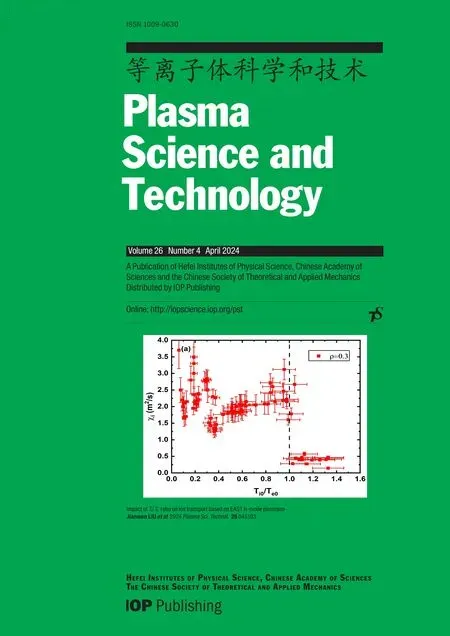 Plasma Science and Technology2024年4期
Plasma Science and Technology2024年4期
- Plasma Science and Technology的其它文章
- Experimental results of a magnetic field modification to the radio frequency driver of a negative ion source
- A fringe jump counting method for the phase measurement in the HCN laser interferometer on EAST and its FPGA-based implementation
- Simulation of liquid cone formation on the tip apex of indium field emission electric propulsion thrusters
- Novel method for identifying the stages of discharge underwater based on impedance change characteristic
- Performance of pulsed plasma thruster at low discharge energy
- Dynamic propagation velocity of a positive streamer in a 3 m air gap under lightning impulse voltage
